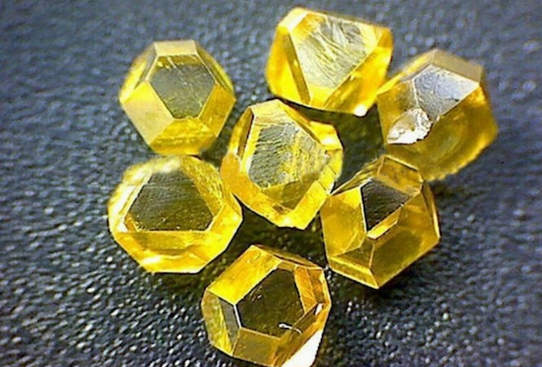
In recent years, synthetic diamonds have been sold online and most traditional jewelry brands have avoided selling synthetic diamonds in their stores, but this year synthetic diamonds are showing up in the windows of more and more traditional jewelry stores this year, offering another option for consumers seeking larger carats at lower prices. Another option for consumers looking for larger, less expensive diamonds.
In September, Market Watch, a U.S. business analysis website, released a report, "Lab Grown Diamond Market Size In 2021 and Data on Top Consumer Countries" (Lab-Grown Diamond Market Size In 2021). Lab-Grown Diamond Market Size In 2021 with Top Countries Data), a report released by Market Watch in September, shows that the market for synthetic diamonds has grown significantly this year compared to last year, and its size has increased significantly.
The Lab Grown Diamond Market Size In 2021 with Top Countries Data shows that the market for HPHT lab diamond is growing significantly this year compared to last year, and is growing at a significant CAGR. Synthetic diamonds appear to be replacing natural diamonds, however, in However, in the eyes of jewelers such as De Beers, who have proposed that "diamonds are forever", the growing market for synthetic diamonds is only a distinction in the diamond market and will not replace natural diamonds. It will not replace natural diamonds.

Why are synthetic diamonds coming from the lab to the market?
Synthetic diamonds, also known as CVD lab grown diamond, have a long history of development. In the middle of the last century, the General Electric Company developed synthetic diamonds in the mid-1900s, but due to technical limitations, these diamonds were brownish-yellow in color and used only for industrial purposes. Since then In 2012, Gemesis, an American synthetic diamond company, announced that it had developed the II diamond. In 2012, Gemesis announced that it had developed the technology to synthesize Type IIa colorless diamonds (diamonds that are very pure in composition and free of nitrogen and other impurities), a major breakthrough in synthetic diamond technology. This was a major breakthrough in synthetic diamond technology, and since then gem-quality synthetic diamond technology has become increasingly sophisticated.

(Early synthetic diamonds were brownish-yellow in color due to technical limitations. Photo credit: Graham Tom)
As the quality of loose lab grown diamond continues to improve and their cost continues to decrease, the market for synthetic diamonds looks very attractive. At the same time, the natural At the same time, the weakening of the natural diamond market has given the synthetic diamond market more room to rise. Diamond Pro, a diamond market information website, reported in September this year In its September report "Ethical diamonds: What Conscientious Consumers Need to Know Consumers Need to Know", Diamond Pro pointed out that consumers have become more environmentally conscious and ethical in recent years, which has significantly influenced their This has significantly influenced the way consumers think about buying diamonds.
Not only does the mining of natural diamonds emit significant greenhouse gas emissions, but the acidic wastewater discharged from diamond mines can pollute local water sources. The University of Waterloo's ecohydrological research team reported in their study, "A diamond mine in the rough" that the mining of natural diamonds is a major source of greenhouse gas emissions. A diamond mine in the rough," the University of Waterloo's ecohydrological research team identified acidic wastewater pollution as the most serious environmental problem caused by the diamond mining industry. In its study, "A diamond mine in the rough," the ecohydrological research team identified acidic wastewater pollution as the most serious environmental problem caused by diamond mining. Michael J. Kowalski, former CEO of the U.S. jewelry brand Tiffany, agrees. According to Michael J. Kowalski, former CEO of Tiffany & Co.

(Pollution of local water sources during natural diamond mining. Photo credit: brilliant earth)
Synthetic diamonds are clearly more environmentally friendly than natural diamonds. U.S. diamond producer Diamond Foundry, in its report, "The Cost to the Environment. Debunking False Advertising by Diamond Miners Miners), the U.S. diamond producer Diamond Foundry states that the carbon emissions from mining natural diamonds are more than twice that of synthetic diamonds. U.S. diamond producer Ada Diamonds' Jason Payne, CEO of U.S.-based diamond producer Ada Diamonds, also said that natural diamonds also emit significant amounts of carbon during production and transportation, but synthetic diamonds do not. Synthetic diamonds have no such carbon emissions.

The more obvious advantage of VVS lab created diamond is the lower price, the current price of synthetic diamonds is about 1/5 of the same grade of natural diamonds, as the technology As technology advances, the price of synthetic diamonds will decrease. In addition, the quality of synthetic diamonds is not significantly different from that of natural diamonds, and they come in a variety of colors.
While natural fancy colored diamonds are extremely rare and rare, synthetic fancy colored diamonds are common. The lower cost of synthetic diamonds also leaves jewelry designers The lower cost of artificial diamond also gives jewelry designers more room for creativity and the ability to experiment with a wider range of cuts.
Synthetic fancy colored diamonds used by Austrian jewelry brand Swarovski Photo credit: the diamond loupe In 2015, Signet Jewelers, the world's largest jewelry and diamond dealer, decided to sell synthetic diamonds, a move that became a turning point for the diamond industry. A turning point for the diamond industry, synthetic diamonds quickly swept the market, posing a considerable challenge to natural diamonds. De Beers announced at the end of 2019 that its natural diamonds would be sold as a result of a weak market. At the end of 2019, De Beers announced a 15% reduction in production of its natural diamonds due to a weak market, and the National Association of Jewellers (UK) CEO Simon Forrester also claimed in 2020 that consumers lack confidence in the natural diamond industry.
Synthetic and natural diamond markets further diverge
Synthetic diamonds are now present in major jewelry stores, and their mass market entry is inevitable, raising the question of whether they can replace natural diamonds. There is widespread concern, but most jewelers and researchers remain confident in natural diamonds.
The Plumb Club, a consortium of 45 of the world's leading jewelry and watch suppliers, released its research report "The Plumb Club 2021" in August of this year. The Plumb Club Industry and Market Insights 2021, which surveyed a sample of 1,049 consumers. The results showed that 21% of consumers did not know about synthetic diamonds and 41% did not know the difference between natural diamonds and synthetic diamonds; 84% of 84% of consumers said they prefer to buy natural diamonds, while only 16% said they prefer synthetic diamonds; 83% of consumers said they prefer synthetic diamonds when buying a wedding or anniversary ring. 83% of consumers would consider buying fashion jewelry made with synthetic diamonds in addition to a wedding or anniversary ring.
Business information website Instore.com considers this research to be a landmark in the diamond industry, indicating that consumers continue to view natural diamonds as more precious than synthetic diamonds. Natural diamonds are still a rare and expensive luxury item and are the top choice when choosing a wedding or anniversary ring. The reason people The reason for this love of diamonds is that De Beers coined the classic "a diamond is forever" advertising slogan in 1947, which has changed forever. The tagline changed the culture of engagement and weddings forever.
The Global Diamond Industry, a study by Columbia Business School, states that diamonds are consumed The Global Diamond Industry, a study by Columbia Business School, identifies the consumption scenarios for diamonds as marriage, gift, collector and everyday wear, with marriage and collector consumption at the top of the diamond consumption structure. Business and Bain & Company, a business and management consulting firm, released its report "Brilliant Under Pressure: The Global Diamond Industry 2020-2021" in February of this year. (Brilliant Under Pressure: The Global Diamond Industry 2020-21), a business and management consulting firm, noted that rising sales of loose synthetic diamonds will gradually lead to an increase in the number of diamonds sold. synthetic diamonds will gradually take over the daily wear market, while natural diamonds will remain the monopoly in other markets with higher levels of consumption. In other markets with higher levels of consumption, natural diamonds will remain the monopoly.
The world's major natural diamond suppliers are aware that synthetic diamonds will differentiate the diamond market and are taking steps to maintain their position in the natural diamond market. The world's major natural diamond suppliers are also aware that synthetic diamonds will differentiate the diamond market and are taking steps to maintain their position. De Beers, the world's largest producer of natural diamonds, launched its synthetic diamond brand Lightbox in 2018, but it Lightbox synthetic diamonds are priced at $800 per carat, which is one-sixth of the average market price for synthetic diamonds. Through its industry position, De Beers is actually using its pricing power to reduce the profitability of synthetic diamonds, further differentiating the diamond market and keeping synthetic diamonds at a flat rate. The company's position in the industry has effectively allowed it to use its pricing power to reduce the profitability of lab grown diamonds, further differentiating the diamond market and keeping synthetic diamonds in the affordable jewelry segment.
In a 2012 study of 1,500 consumers conducted by the Antwerp World Diamond Center (AWDC) and Bain & Company, the question "What do you think of when you think of synthetic diamonds? synthetic diamonds?" "Artificial" and "fake" were the words that came to mind most often.
The results of this study are still persuasive today, and the market for natural and synthetic diamonds will continue to diverge. Cvd Loose diamond can be as long-lasting as natural diamonds, but they are not a substitute for the "eternal" value that natural diamonds are given. The connotation of "permanence". Bain & Company, in its report "Brilliance Under Pressure: The Global Diamond Industry 2020-2021," foresees the expansion of synthetic diamonds to a broader mass jewelry segment, targeting a different audience than natural diamonds; because of the difference in price and rarity, the audiences and positioning of synthetic and natural diamonds are becoming increasingly distinct. Because of the differences in price and rarity, the audiences and positioning of synthetic and natural diamonds have gradually diverged, and the trend toward a graded diamond market will further evolve.














